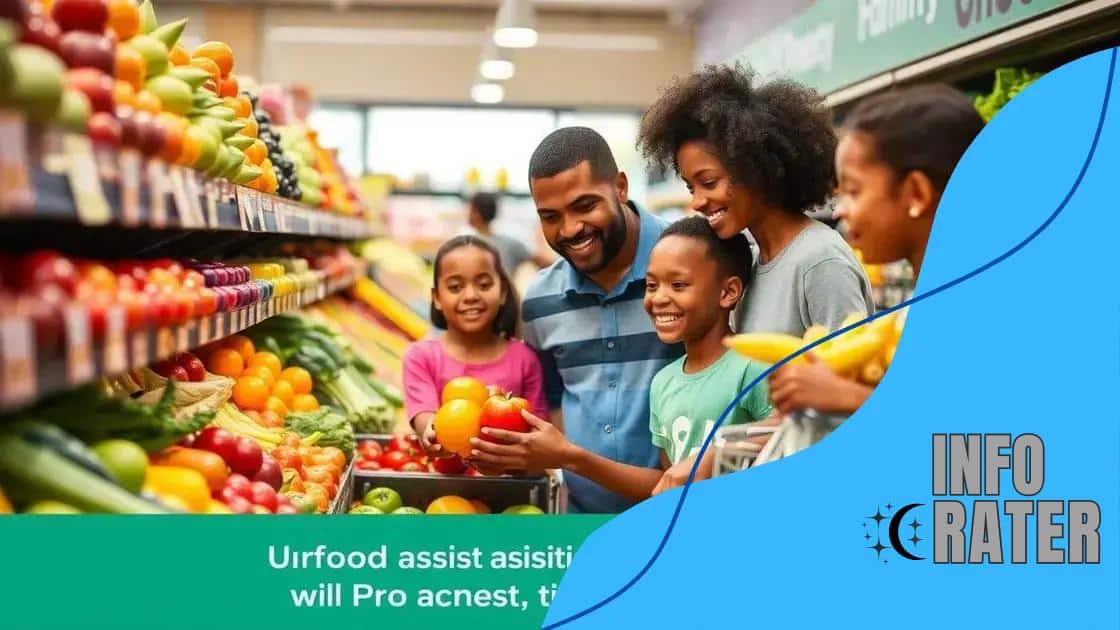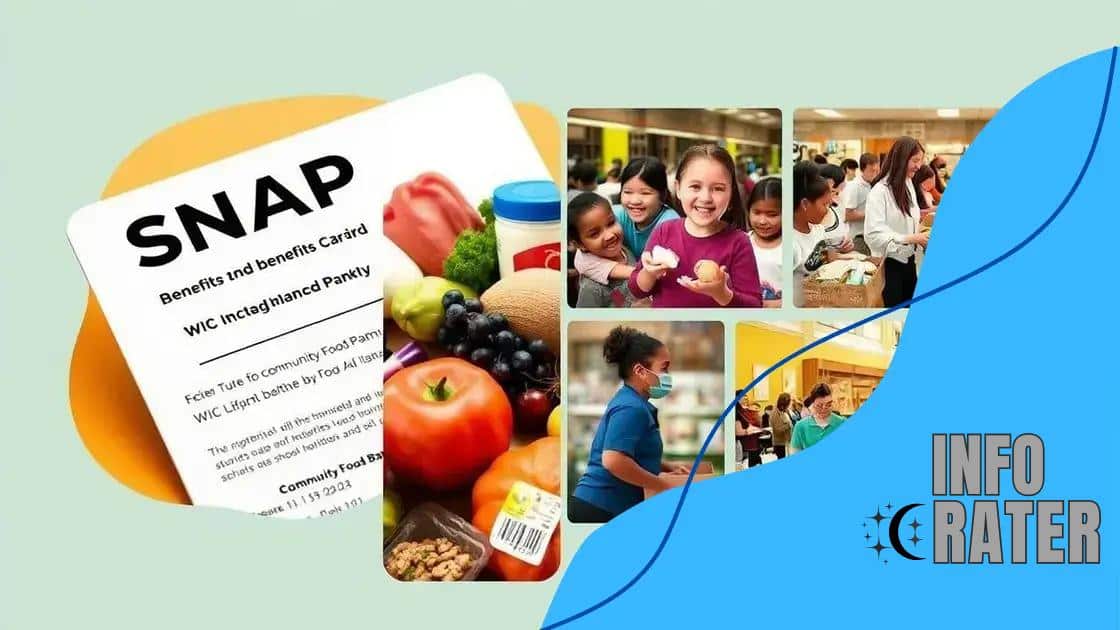Food assistance programs for low-income families: a guide

Food assistance programs provide critical support to low-income families by offering access to nutritious food, reducing financial stress, and increasing food security through various initiatives like SNAP, WIC, and food banks.
Food assistance programs for low-income families are designed to ease the burden of food insecurity. Have you ever wondered how these programs can make a difference in your daily life? Let’s explore the options together.
Understanding food assistance programs
Understanding food assistance programs is essential for families facing challenges with food security. These programs provide crucial support to help individuals access nutritious food. Many people may not know that help is available, so let’s break down these resources.
Types of Food Assistance Programs
There are various types of food assistance programs that cater to different needs. These include:
- Supplemental Nutrition Assistance Program (SNAP)
- Women, Infants, and Children (WIC)
- National School Lunch Program (NSLP)
- Food banks and pantries
Each program has its unique eligibility requirements and benefits. For example, SNAP provides monthly benefits to purchase food, while WIC focuses on the nutritional needs of pregnant women and young children.
Eligibility Criteria
Eligibility for food assistance programs often depends on income, household size, and certain demographic factors. It’s important to check the specific requirements for each program. Many families qualify without realizing it. Additionally, some programs cater specifically to children or the elderly, ensuring all demographics have access to assistance.
Moreover, applying for assistance can be simple and straightforward. Most programs allow online applications, which make it easier for families to receive help when they need it most. Staying informed about the options available is critical, and outreach efforts often provide the necessary knowledge to those in need. Community organizations often play a big role in educating families about these resources.
Overall, understanding food assistance programs can empower families to seek the help they require. By knowing what’s available, families can gain access to healthier foods and improve their overall wellbeing.
Eligibility criteria for participation
Knowing the eligibility criteria for participation in food assistance programs is crucial for families seeking support. Many may qualify without realizing it, and understanding these criteria can help individuals and families access the help they need.
Common Requirements
Eligibility often depends on a few key factors, including:
- Income level relative to the federal poverty line
- Household size and composition
- Residency in the state where applying
- Citizenship status or certain non-citizen qualifications
For instance, families with an income under a certain threshold typically qualify for programs like SNAP. Additionally, the number of people in a household can influence benefits provided, as larger families may qualify for more support.
Application Process
To apply for assistance, potential participants usually fill out an application that requires personal and financial information. It’s essential to gather documents like pay stubs, tax returns, and proof of residency. This information helps determine eligibility.
While some programs have strict timelines, others may offer year-round opportunities to apply. If a family misses a deadline, they might face another chance during open enrollment periods. Knowing these timelines can be valuable.
As applicants consider food assistance programs, they should reach out to local organizations for help. Many nonprofits and food banks can assist with the application process, making it less overwhelming.
Types of food assistance available

There are several types of food assistance programs available to help low-income families access nutritious meals. Understanding these different options can empower families to choose the best support for their needs.
Supplemental Nutrition Assistance Program (SNAP)
The Supplemental Nutrition Assistance Program (SNAP) is one of the most well-known programs. It provides monthly benefits to eligible families to purchase food. SNAP benefits are loaded onto an electronic card, making shopping easy and discreet.
Women, Infants, and Children (WIC)
The Women, Infants, and Children program, or WIC, focuses on the nutritional needs of pregnant women, nursing mothers, and young children up to five years old. WIC offers healthy food options, nutrition education, and referrals to healthcare services.
National School Lunch Program (NSLP)
Another key program is the National School Lunch Program (NSLP). This initiative provides free or reduced-price lunches to children in eligible schools. Ensuring children have access to healthy meals during the school day helps improve their concentration and learning.
Food Banks and Pantries
In addition to formal programs, food banks and pantries play a vital role in food assistance. These organizations collect and distribute food directly to families in need. Many community centers and religious organizations support food bank initiatives.
Each of these food assistance programs offers unique benefits tailored to specific populations. By understanding the diversity of options, families can better navigate the resources available to them. This knowledge can lead to improved dietary choices and overall health.
How to apply for food assistance programs
Applying for food assistance programs can be a straightforward process if you know the steps to follow. Understanding these steps can help ensure that families receive the support they need without unnecessary stress.
Gather Necessary Documents
The first step in the application process is to gather the necessary documents. Commonly required documents include:
- Proof of income, such as pay stubs or tax returns
- Identification, like a driver’s license or state ID
- Social Security numbers for all household members
- Proof of residency, such as a utility bill
Having these documents ready will speed up the application process. Be sure to check the specific program requirements as they can vary.
Complete the Application
Next, applicants can complete the application. Many programs offer online applications that are user-friendly. You can also find paper applications at local offices or community organizations. When filling out the application, be thorough and accurate to avoid delays.
Once submitted, the application will be reviewed by program staff. They may contact you if they need additional information. It’s essential to respond promptly to any requests to keep the process moving smoothly.
Follow Up
After submitting the application, remember to follow up. You can check the status of your application by calling the relevant office or visiting their website. Staying informed about your application helps you know when to expect assistance.
In some cases, applicants may be required to attend an interview. This is a normal part of the process and helps determine eligibility. During the interview, be ready to discuss your financial situation and household details.
By knowing how to apply for food assistance programs, families can take important steps toward securing the help they need. Being informed about the process makes it easier to navigate and access valuable resources.
Benefits of food assistance for families
The benefits of food assistance programs for families are far-reaching and essential for those facing food insecurity. These programs provide much more than just food; they offer vital support that can improve the overall quality of life for individuals and households.
Nutritional Improvement
Access to food assistance ensures that families can obtain nutritious foods. Healthy meals contribute to better physical health and reduce the risk of diet-related diseases. By receiving assistance, families can make food choices that promote well-being, which is crucial for growing children.
Financial Relief
Participating in food assistance programs can alleviate financial stress. With the rising cost of living, families often struggle to afford basic necessities. By utilizing programs like SNAP or WIC, families can redirect their limited resources towards other essential expenses, such as housing and healthcare. This financial relief can be a game changer for those in tight financial situations.
Increased Food Security
Food assistance programs help ensure that families have consistent access to enough food. This increased food security reduces anxiety about where the next meal will come from and allows families to focus on other areas of life, such as education and employment.
Moreover, less stress about food can lead to improved mental health. Families can experience a sense of stability, fostering a healthier home environment. Programs also encourage participation in community activities, enabling social support networks to develop.
In summary, the benefits of food assistance programs extend beyond just filling bellies; they enhance overall family dynamics, health, and financial stability. Understanding these benefits can encourage more families to seek assistance.
FAQ – Frequently Asked Questions about Food Assistance Programs
What are food assistance programs?
Food assistance programs are government and nonprofit initiatives that provide help to low-income families to access nutritious food.
How can I qualify for food assistance?
Eligibility generally depends on income level, household size, and residency status. Each program may have specific requirements.
What types of food assistance are available?
Common types include SNAP, WIC, the National School Lunch Program, and various food banks and pantries.
How do I apply for food assistance?
You can apply online or in person, typically by filling out an application and providing necessary documentation such as proof of income and residency.





